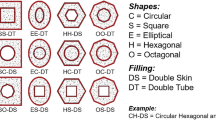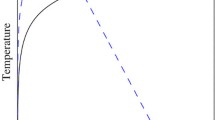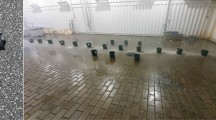Abstract
The structural fire behavior of typical load-bearing drywall systems, consisting of light cold-formed steel (CFS) studs, sheathed with single or double layers of gypsum plasterboards and air cavity or mineral wool insulation, is investigated. For that purpose, an efficient numerical modeling approach with satisfying accuracy is developed and validated against experimental and numerical results available in the literature. Heat transfer and structural analyses of the investigated drywall assemblies are carried out, employing the computational tools ANSYS CFX and ADINA, respectively. Transient heat transfer analyses provide the spatial and temporal temperature variation over the drywall assembly, which is assumed to be exposed to the standard ISO 834 fire curve from one side. Thermal simulation results are then introduced in the subsequent structural analyses, where the load-bearing capacity of the CFS studs under fire conditions is estimated, by means of Geometry and Material Nonlinear Analyses accounting for Imperfections (GMNIA). The load-bearing capacity assuming uniform cross-sectional temperature distributions is also evaluated and compared to the respective predictions under non-uniform temperature profiles. Results obtained by varying the imposed load or the applied temperature (fire duration), are compared to predictions of existing and literature-proposed fire design guidelines. EN 1993-1-2 provisions lead to average underestimation of the load-bearing capacity by approximately 20%, while the literature-proposed methods are found to underestimate the load-bearing capacity by 5% to 15%. The limitation of using a critical temperature of 350°C for the structural fire design of thin-walled sections is found to be rather conservative, since the investigated CFS studs are able to exhibit satisfying fire performance also under higher temperature conditions.
















Similar content being viewed by others
References
Alfawakhiri F, Sultan MA, MacKinnon DH (1999) Fire resistance of loadbearing steel-stud walls protected with gypsum board: a review. Fire Technol 35:309–335. doi:10.1023/A:1015401029995
Chen W, Ye J, Bai Y, Zhao XL (2012) Full-scale fire experiments on load-bearing cold-formed steel walls lined with different panels. J Constr Steel Res 79:242–254. doi:10.1016/j.jcsr.2012.07.031
Gunalan S, Kolarkar P, Mahendran M (2013) Experimental study of load bearing cold-formed steel wall systems under fire conditions. Thin-Walled Struct 64:72–92. doi:10.1016/j.tws.2013.01.005
Kolarkar P, Mahendran M (2012) Experimental studies of non-load bearing steel wall systems under fire conditions. Thin-Walled Struct 65:72–92. doi:10.1016/j.tws.2013.01.005
Feng M, Wang YC (2005) An experimental study of loaded full-scale cold-formed thin-walled steel structural panels under fire conditions. Fire Saf J 40:43–63. doi:10.1016/j.firesaf.2004.08.002
Kolaitis DI, Founti MA (2013) Development of a solid reaction kinetics gypsum dehydration model appropriate for CFD simulation of gypsum plasterboard wall assemblies exposed to fire. Fire Saf J 58:151–159. doi:10.1016/j.firesaf.2013.01.029
Sultan MA, Kodur VR (2000) Light-weight frame wall assemblies: parameters for consideration in fire resistance performance-based design. Fire Technol 36:75–88. doi:10.1023/A:1015446207222
Keerthan P, Mahedran M (2012) Thermal performance of composite panels under fire conditions using numerical studies: plasterboards, rockwool, glass, fibre and cellulose insulations. Fire Technol 49:329–356. doi:10.1007/s10694-012-0269-6
Gunalan S, Bandula Heva Y, Mahendran M (2014) Flexural–torsional buckling behaviour and design of cold-formed steel compression members at elevated temperatures. Eng Struct 79:149–68. doi:10.1016/j.engstruct.2014.07.036
Ranawaka T, Mahendran M (2009) Distortional buckling tests of cold-formed steel compression members at elevated temperatures. J Constr Steel Res 65(2):249–259. doi:10.1016/j.jcsr.2008.09.002
Gunalan S, Bandula Heva Y, Mahendran M (2015) Local buckling studies of cold-formed steel compression members at elevated temperatures. J Constr Steel Res 108:31–45. doi:10.1016/j.jcsr.2015.01.011
Standards Australia (2005) AS/NZS 4600 Cold-formed steel structures. Sydney
European Committee of Standardization (2002) EN 1993-1-2 Eurocode 3: Design of steel structures—Part 1–2: General rules-structural fire design, Brussels, Belgium
European Committee of Standardization (2006) EN 1993-1-3 Eurocode 3: Design of steel structures—Part 1.3: General rules-Supplementary rules for cold-formed members and sheeting, Brussels
European Committee of Standardization (2004) EN 1993-1-5 Eurocode 3: Design of steel structures—Part 1.5: General rules-Plated structural elements, Brussels
British Standards Institution (1998) British Standard 5950: Structural use of steelwork in buildings, Part 5: Code of practice for design of cold-formed thin gauge sections. London
American Iron and Steel Institute (AISI) (2007) Specifications for the cold-formed steel structural members, Cold-formed Steel Design Manual. Washington
Landesmann Α, Camotim D (2015) DSM to predict distortional failures in cold-formed steel columns exposed to fire: Effect of the constitutive law temperature-dependence. Comput Struct 147:47–67. doi:10.1016/j.compstruc.2014.09.021
Shahbazian A, Wang YC (2014) A fire resistance design method for thin-walled steel studs in wall panel constructions exposed to parametric fires. Thin-Walled Struct 77:67–76. doi:10.1016/j.tws.2013.12.001
Cheng S, Li LY, Kim B (2015) Buckling analysis of partially protected cold-formed steel channel-section columns at elevated temperatures. Fire Saf J 72:7–15. doi:10.1016/j.firesaf.2015.02.010
Dimopoulos CA, Gantes CJ (2012) Comparison of alternative algorithms for buckling analysis of slender steel structures. Struct Eng Mech 44:219–238
Feng M, Wang YC (2005) An analysis of the structural behaviour of axially loaded full-scale cold-formed thin-walled steel structural panels tested under fire conditions. Thin-Walled Struct 43:291–332. doi:10.1016/j.tws.2004.07.008
ANSYS 15.0 (2013) User’s Guide ANSYS Inc. Canonsburg
ADINA System 8.5 (2008) Release Notes ADINA R&D Inc. Watertown
International Standards Organization (1999) ISO 834-1 Fire-resistance tests—elements of building construction—Part 1: General requirements
Cooke GME (1987) Thermal bowing and how it affects the design of fire separating construction. Fire Research Station, Borehamwood
Gantes CJ, Fragkopoulos ΚΑ (2010) Strategy for numerical verification of steel structures at the ultimate limit state. Struct Infrastruct Eng 6(1–2):225–255. doi:10.1080/15732470802664449
Gunalan S, Kolarkar PN, Mahendran M (2013) Finite element modelling of load bearing cold-formed steel wall systems under fire conditions. Eng Struct 56:1007–1027. doi:10.1016/j.engstruct.2013.06.022
Gunalan S (2011) Structural behaviour and design of cold-formed steel wall systems under fire conditions. Ph.D. Thesis, Queensland University of Technology, Australia
Benichou N, Sultan MA, MacCallum C, Hum J (2001) Thermal properties of wood, gypsum and insulation at elevated temperatures. National Research Council, Canada
DiNenno PJ (2002) SFPE Handbook of fire protection engineering, 3rd edn. National Fire Protection Association, MA, USA
International Standards Organization (1996) ISO 6946 Building components and building elements—Thermal resistance and thermal transmittance—Calculation method, Switzerland
Ghazi Wakili K, Hugi E, Wullschleger L, Frank T (2007) Gypsum board in fire-modeling and experimental validation. J. Fire Sci 25:267–282. doi:10.1177/0734904107072883
Asimakopoulou EK, Kolaitis DI, Founti MA (2015) Fire safety aspects of PCM-enhanced gypsum plasterboards: An experimental and numerical investigation. Fire Saf J 72:50–58. doi:10.1016/j.firesaf.2015.02.004
American Iron and Steel Institute (AISI) (2008) Strength of Cold-Formed Steel Jamb stud-to-track connections, Research report RP08-1. Washington DC, USA
Zhao B, Kruppa J, Renaud C, O’Connor M, Mecozzi E, Apiazu W, Demarco T, Karlstrom P, Jumppanen U, Kaitila O, Oksanen T, Salmi P (2005) Calculation rules of lightweight steel sections in fire situations. Technical Steel Research, EU
Kankanamge ND, Mahendran M (2011) Mechanical properties of cold-formed steels at elevated temperatures. Thin-Walled Struct 49:26–44. doi:10.1016/j.tws.2010.08.004
Anderberg Y (1986) Modelling steel behaviour. In: International conference on design of structures against fire. Birmingham, UK
Schafer BW, Peköz T (1998) Computational modelling of cold-formed steel: characterizing geometric imperfections and residual stresses. J Constr Steel Res 47:193–210
ABAQUS user’s manual (2009) Inc. (HKS), USA
Acknowledgments
This work has been financially supported by the “Fire-FACTS” project in the frame of the ARISTEIA action (operational programme “Education and Lifelong Learning”) that is co-financed by Greece and the E.U. and by the E.C. in the frame of FP7 Project “ELISSA: Energy Efficient Lightweight-Sustainable-Safe-Steel Construction” (EeB.NMP.2013-1, Grant No. 609086).
Author information
Authors and Affiliations
Corresponding author
Rights and permissions
About this article
Cite this article
Thanasoulas, I.D., Vardakoulias, I.K., Kolaitis, D.I. et al. Thermal and Mechanical Computational Study of Load-Bearing Cold-Formed Steel Drywall Systems Exposed to Fire. Fire Technol 52, 2071–2092 (2016). https://doi.org/10.1007/s10694-016-0604-4
Received:
Accepted:
Published:
Issue Date:
DOI: https://doi.org/10.1007/s10694-016-0604-4




